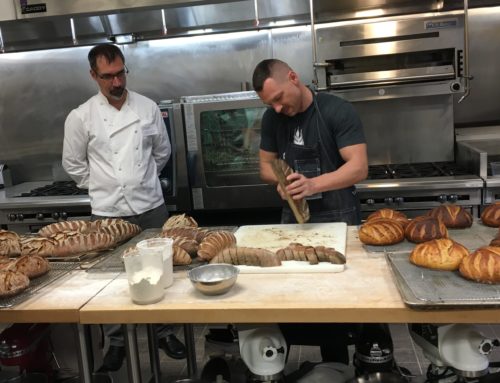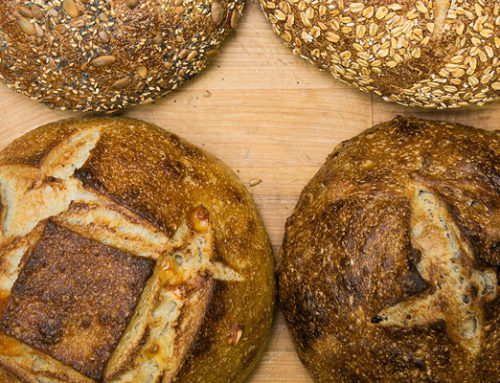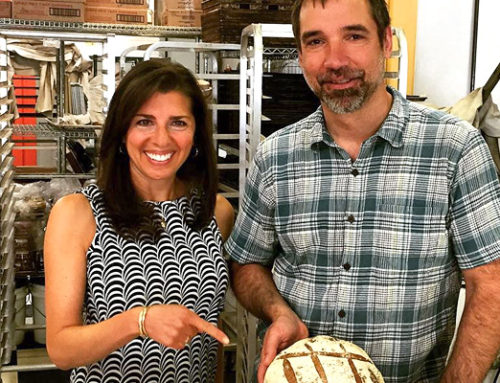Farewell to the Matador
Matador
May 13, 2021
by Greg Carpenter, Founder, Crooked Tree Breadworks
In August, 1996, I had snuck away from the bakery buildout to join my extended family for lunch, all of whom had come to town to see the first member of our next generation, my 2-month-old daughter Ivy. When the phone call came, the builder on the other end of the line simply said “It’s here”. I kissed Ivy on the forehead, handed her to her grandfather and headed back to the new storefront.
Turning into the brand-new parking lot, I saw a tractor-trailer flatbed rig with a large, heavy-looking mass centered between the axles. Pulling in behind me came a mobile crane, the critical tool for getting the oven into the building. Which was not easy. To fit the 15,000 pound chunk inside, the crew had to use a concrete saw, cutting the double doors free from their block walls to gain inches of clearance. They then progressively transferred the weight from the crane to the slab foundation inside the doorway. Using a winch and heavy machinery casters, they pulled the oven into place. This well-choreographed operation went off flawlessly thanks to a very skilled crew.
Once the crane had left, I stood looking at the 10x6x7 monolith of masonry and stainless steel, “Matador” proudly emblazoned on its hood, overwhelmed by a potent mix of anxiety and ambition. This old, used, mysterious oven would be the heart of a dream I’d been working toward for years. Would it even work? I had never baked with a steam-injected deck oven. Would I be able to figure it out? Would I ever recover the money I had to borrow to follow this dream?
I was lucky to find the Matador at all. In 1996 when I built Crooked Tree Breadworks, there were few brokers in the country that could source a deck oven, or, in the jargon of the time, “European-Style Bread Oven”, and they were mostly concentrated near the urban coasts. I called every bakery equipment dealer in the Midwest. When I asked about deck ovens, each pointed me toward the large, rotating shelf ovens, common in the bagel shops that were springing up on every corner. When I described what I really needed, I was usually dismissed with a comment such as “OK, son, good luck with that… why aren’t you making bagels?”
A brand new, installed deck oven from one of the coastal reps would have cost 4 times my budget, and finding a used one was proving to be nearly impossible. I was feeling dispirited and disgruntled when, perusing a list of suppliers in a bakery trade buyer’s guide, I stumbled across a broker in Sterling Heights, Michigan, named Bob Snoor. Throwing yet another Hail Mary, I gave Bob a call. To my great relief, he not only knew exactly what I was looking for but knew where to find one, used, in good working condition. The oven was in storage within a day’s drive in Kitchener, Ontario.
The following week I drove to Kitchener and met Bob at a warehouse along with Anton Sproll, the German baker who owned the oven. It appeared to be in good condition, with a cool, late sixties, German aesthetic, and Mr. Sproll assured me that it was in working order. Built in 1970, it had been used in Germany until 1987, when he purchased it and had it shipped to Kitchener as part of a plan to expand his bakery. After his financial partner pulled out of the expansion deal, Mr. Sproll was left holding the oven for several years, until he decided to sell it.
We went back to Sproll’s bakery and watched a team of bakers work three similar Matadors at a time, creating delicious sourdough rye loaves with amazing crust. I reveled in the purpose-specific ovens, which I had never seen in use before. The bakers were loading and unloading them continuously, and I was enthralled. Over lunch and a handshake, I agreed to purchase the Matador.
Back in Michigan I finalized the financing for the project, and the first check I wrote out of those funds was for payment on the Matador. Even though I bought the oven for what I would later learn was a steal, to my minimum-wage sensibilities, the amount seemed impossibly large. As I scribed the check, I remembered the advice of my friend, Les Arnold, the general contractor for the bakery buildout: “You have reached the point now where you need to think of it as other people’s money. Be confident and cut the checks.”
In hindsight, I cannot believe how lucky I was. Once Les and the crew had the Matador up and running it became clear that it was indeed a first-class oven in fine working order. Now came the hard part. Would my skills transfer to this new method of baking?
I had learned to bake while working in the R&D kitchen at American Spoon Foods, the groundbreaking farm-to-table producer of small-batch preserves in my hometown. In that environment, food mentor Chef Chris Chickering and I were encouraged to innovate, and our experiments extended to oven design. We knew we could never get the crisp, caramelized crust we desired using a regular convection oven or a rotating shelf oven; such a loaf requires a bake chamber with thermal mass and the ability to hold steam as the loaves “sprung” to their full size. Chris, Les, and I put our heads together and decided to see what we could create on a shoestring. We purchased a used, stone-hearth pizza oven and designed a steam injection system using drilled copper tubing and steel channel. We named our creation “Ol’ Crusty” and I spent 2 years in front of it refining my baking skills. By the time I opened Crooked Tree Breadworks in 1996, Ol’ Crusty’s floor was rusted out and the steam channels had mostly corroded away. Ol’ Crusty didn’t have another year left in him.
The Matador was something else entirely. More thermal mass, more steam, oven loaders designed to accurately place loaves throughout the bake chamber, 6 times more capacity… it was a dream come true. Once the bakery was fully fitted out and operational, I spent a week developing production systems that took advantage of this fantastic oven. The loaves that emerged from it, from the very first test batch, had great, golden crust and volume that Ol’ Crusty and I could never achieve. For an entire week before I opened the store, I monitored sourdough starters and tested formulas, leaving the front door open so that interested passers-by could come in and ask questions. While many were openly skeptical of the wisdom of opening a boulangerie in Petoskey (in 1996 the food scene here was NOT what it is now, and people were largely suspicious of the words “crusty sourdough”) I made sure everyone left with a free loaf. All were impressed by the Matador. Those early curiosity seekers became Crooked Tree Breadworks best marketing asset, spreading the word and creating buzz. With their help, our business started off on the right foot.
It would be very difficult to calculate the total number of hours I have spent in front of the Matador. When I started the business, I was a one-man show. I quickly realized that working from 4 AM to 8 PM every night was a good way to end up tired, broke, and alone, and that if I ever wanted to see my daughter again, I was going to need some help, so I hired a small staff to help with prep and to get our line of scones, muffins, and cookies off the ground. I remained the head baker, performing the lion’s share of mixing, shaping, and baking. Throughout that time of early parenthood stress, accelerated business education, staffing headaches, and sleep deprivation, the Matador was an unflappable, calming presence, the one thing I did not have to worry about.
In late 1999 we increased our storefront to its current dimensions. Over the next 10 years, I refined our baking system, making it more teachable. My baking skills gradually evolved from “unconsciously competent” to “consciously competent”, as I created a self-sustaining team of skilled bakers. In 2010, I reduced my 5 weekly shifts of production baking, handing off some of the physically demanding, sensuous job of bread baking as the needs of the growing business pulled me into the office to work on its other necessary systems.
Now, as I sit here at my desk, I can barely hear the comforting whir of the circulation fan on the Matador outside my door, its robust, over-engineered, 3-phase motor still vibration-free after all these years. But a look beneath the surface would confirm what I already know. The heat exchangers are rusty, the wiring is getting brittle, the electrical relays are getting sticky, the combustion chamber is coated with soot from years of flour-dusted intake air, the masonry hearths have cracks in them that continue to grow, and the hot spots keep getting hotter as the cool spots get cooler.
The world is not the same as it was in 1996. My daughter Ivy will be 25 this June, and three more children (Eli, Kate, and Quinn) have since enriched my life. My wife, Becky, and each of my children have contributed much time and labor to the success of Crooked Tree Breadworks. The business has survived the Atkins diet (Bad Carbs! Bad Carbs!) the brutal recession of 2008, and the current COVID crisis, staying strong by keeping an eye on the mission. All the while, the Matador has dutifully hummed in the background, providing consistently beautiful loaves.
and Quinn) have since enriched my life. My wife, Becky, and each of my children have contributed much time and labor to the success of Crooked Tree Breadworks. The business has survived the Atkins diet (Bad Carbs! Bad Carbs!) the brutal recession of 2008, and the current COVID crisis, staying strong by keeping an eye on the mission. All the while, the Matador has dutifully hummed in the background, providing consistently beautiful loaves.
It is sad to know that today the final batch of, golden, crusty loaves will emerge from the Matador at the hands of our skilled crew of bakers. But these same bakers will honor the tradition that began in front of the Matador, taking Crooked Tree Breadworks into the next 25 years with the help of a brand new, beautiful Italian oven of nearly identical design. Good design does, indeed, endure.











